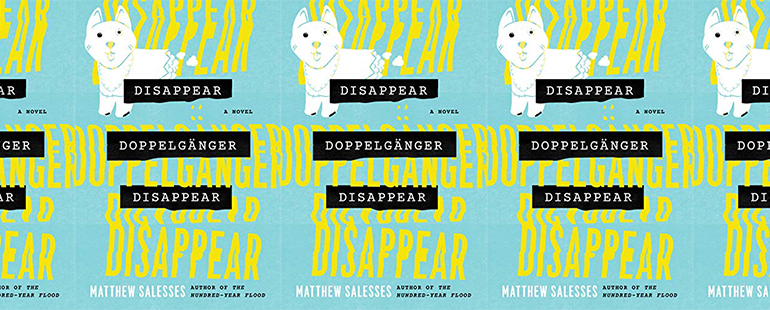“Racism makes it difficult to love yourself”: An Interview with Matthew Salesses

For Black, Indigenous, and Non-Black people of color, the feelings of chaos and turmoil everyone has been experiencing these past few months span generations, not weeks, and the feeling of powerlessness is something they’ve long been desperate to change or escape from. What if, in the midst of these feelings, you found a yellow thread on the ground and followed it through a crack in a wall, and in the city on the other side, there was another life waiting for you, one your doppelgänger has been living, with different decisions and different outcomes. What if you could abandon your existence for this parallel one? What if there was a better you, or a better world, to be had?
These are some of the questions Matthew Salesses’s new novel Disappear Doppelgänger Disappear asks. His previous novel, the best-selling The Hundred-Year Flood, also tackled themes of identity and relationships, following a protagonist on his journey to embrace his existence as both an adopted son and a person of mixed race in America. Disappear Doppelgänger Disappear builds on those themes, showing both what could be and what isn’t and making us question how we gauge our reality, no matter where we come from or where we’re headed.
The book’s main character, Matt Kim, is divorced, his relationship with his daughter is nearly non-existent, and his girlfriend, Yumi, isn’t thrilled with where things are, either. Plus, Matt’s cat has recently died and he keeps thinking he hears it meowing from inside the ceiling. Stranger still, Matt is introduced to Sandra, an exact lookalike of Yumi who bears her former American name. Sandra has a boyfriend named Matt, and he’s recently disappeared. This is where Salesses drops us within the first few chapters of Disappear Doppelgänger Disappear, and the peculiarities only escalate. Soon Matt finds the yellow thread—laid like a calling card meant exclusively for him. When he follows it, he finds himself moving through a wall into a parallel universe where Boston is not really Boston, Yumi is Sandra, the other Matt may have been murdered, and the air is filled with what he can only describe as “jello.”
Salesses wrote this novel during his wife’s cancer treatment and continued working on it after her passing. The book became his escape from tragedy. The narrative, too, initially centers on escape. Matt Kim is stuck, but it isn’t the kind of stuck where you just change jobs or start a new relationship. Matt is stuck in the way where he doesn’t know what to do and hasn’t for so long that he’s become apathetic, grossly lost. When Yumi opens the door to a car and reveals her doppelgänger Sandra for the first time, Matt is startled into a journey of escape, attempting to evade his own life and all the baggage that goes with it. “Maybe it was simple,” he says. “Without freedom you appreciate your freedom. You want what you don’t have. I wanted the other Matt’s life.”
But the novel quickly branches out from escape into turbulent discord. Whatever Matt wants seems to be just out of reach, and when he does reach, he falls short, or the goal changes, or the situation shifts. It’s like when your parents hold their arms out in the pool and, once you’re under and swimming, inch away to challenge your skills. Matt’s life continually inches away each time he moves between worlds, yet he persists in the struggle because he is searching to “love better,” to become a “better Matt,” and he suspects he can achieve this on the other side of the yellow-threaded wall, or by deconstructing himself in some way: “For the first time—at least for the first time consciously—I was disappearing myself. And it felt surprisingly good, troublingly good. I was disappearing not through failing to appear but by dismantling the appearance of my life.”
These themes of escape and powerlessness are part of a much larger focus Salesses’s work has on racism and the resulting loss of identity. Disappear Doppelgänger Disappear is a book about what identity means, where it comes from, and how it is policed. As a means of framing the narrative, Salesses prefaces the book with this factual and “abbreviated list of disappearances”:
1875 Page Act
1882 Chinese Exclusion Act
1907 Gentlemen’s Agreement
1917 Asiatic Barred Zone Act
1924 Immigration Act
1934 Tydings-McDuffie Act
1942 Executive Order 9066
Salesses wants the reader to be conscious of these moments in history in which immigrants and people of color were restricted, disappeared, before the book even begins. These disappearances thread into later political references the protagonist, Matt, makes to Trump’s election and administration: “Twenty feet back, at the edge of my sense-circle, two white dudebros pretended to chat. They wore hats that said something about this country we all lived in, that it wasn’t great anymore.” As such, Disappear Doppelgänger Disappear turns a keen ear to both the disappearances that can happen within us, as when Matt is searching to better himself, but also in how the dismantling of identity can be forced upon us by outside forces. This undercurrent of systemic racist erasure strengthens as the novel goes on, poignantly illustrating how governments can easily make people of color invisible. So, as Matt struggles to keep his life upright in the face of doubles and break-ups and murders, there are mounting mentions of political affronts and deep-seated racial inequalities, culminating in a moment in which Matt begins to wonder if he’s losing himself in two ways, if “assimilation is disappearance.”
Disappear Doppelgänger Disappear tackles the construction of racial identity and related political maelstroms with ease, humor, and genuine grace. Science fiction in its exploits and shifts in time, the novel is a complex story that tickles with its cracks in the walls and mysterious layers. Salesses has created something admirable, witty, and profound, which will certainly enter the canon of books rooting out discrimination and oppression. He’s written a novel of doppelgängers that begins forging its own double, a book that attempts to confront the vast problems of racial inequality both in its plot and in its meta-structure, asking if there might be a parallel world for our own, one where these injustices could be corrected—or wondering if that, too, is pure fantasy. I recently chatted with him about his artistic influences, tending to a large cast of characters, real life colliding with the world of a novel, and the book’s political aspirations.
J. A. Tyler: At the onset, Disappear Doppelgänger Disappear reminded me of a few other works: Shane Jones’s Vincent and Alice and Alice, Charles Yu’s How to Live Safely in a Science Fictional Universe and Interior Chinatown, and the film Eternal Sunshine of the Spotless Mind. What kind of cultural moments or references spurred you during the writing of this type of realist/surrealist novel?
Matthew Salesses: This is interesting. I started out thinking I’d try writing a [Haruki] Murakami novel set in America, with Asian American problems instead of Japanese ones. I also wanted to write a book that switched between one world and its shadow world, like Zelda: Ocarina of Time.
JAT: It’s funny, we often don’t hear enough about the outside influences on writers beyond the written word, in things like video games. What are some other non-book items that impacted your thinking about this novel?
MS: I’m always trying to write a K-drama, honestly. I also think it’s the closest visual form to a novel. It has similar structural moves and a clear beginning, middle, and end. I also wish I could recreate the experience of standing in a museum, which is like standing in another world full of glimpses into other worlds. Sort of like the mind/time bubbles in the novel.
JAT: Because the novel spools and unspools in so many directions, and with so many characters and their doppelgängers, I’m wondering, from a craft perspective, how you tended to the loops and overlaps. Sticky notes, lists, a giant scroll of paper à la Slaughterhouse-Five?
MS: I just read the thing over so many hundreds of times. I also think that objects really help a lot in managing multiple subplots. The toys, the dog-half of the stuffed animal, and so forth, were ways that I tried to keep the storylines going in readers’ heads by associating them with concrete things. Late in the process, I needed some more characters because of the fundraiser Margaret Rhee ran for me when my wife had cancer—a couple of the prizes were naming characters after the donors. Plus, living a life that’s constantly like living multiple lives really prepares you for the simultaneity of living in a novel and also in the world and also in the novel you wish your novel was and also the world you wish your world was and also the novel your novel actually is and the world actually is, etc.
JAT: You were writing this novel as your wife received her cancer diagnosis and underwent treatment, and continued the work after losing her. How did you, as a novelist or even just as a human being, hold this book together when so much in your life was devastatingly in flux?
MS: I wrote a ton during that time, often sitting by my wife’s side as she slept off chemo treatments. Probably the writing was a major way in which I was able to hold things together, to process melancholy, and to funnel all the feelings into something that felt useful in some small way, that felt alive. Fiction also offers the control that I rarely have in life. I needed some realm in which my desires felt like they had some kind of agency.
JAT: In your essay “To Grieve Is to Carry Another Time,” you wrote about Capgras delusion, first identified in 1923 as “the belief that a loved one has been replaced by an imposter.” This is pervasive Disappear Doppelgänger Disappear. For your characters, how much of this is syndrome and how much is instead wishing or hoping for something better than what they have?
MS: The syndrome is racism, which really does produce a similar phenomenon, where it is hard to recognize yourself and the ones you love because of the power of the images racism creates for people. For Matt, too, the Capgras delusion is really himself—he feels as if he is the imposter. Racism makes it difficult to love yourself, and encourages people to make themselves into the image racism prefers, in order to get some sort of approval. That’s the model minority myth/syndrome. You don’t know how to love because you don’t know how to recognize each other except as imposters.
JAT: The character Matt meets Matthew Salesses, the novelist. How did it feel to put a version of yourself into this book, and how did that decision come about?
MS: Ha, I didn’t mean for the Matthew Salesses character to be me. He’s a sort of white savior type who sets himself up in an underprivileged neighborhood as an under-the-table doctor. The question, for me, was: who is the disappearer? Who is the murderer in the murder mystery of the self? Personally, it’s this version of me. I wrote this in because I wanted to make it clear that I am personally invested and have high personal stakes in the novel.
JAT: On a sentence level, one interesting element of Disappear Doppelgänger Disappear is your choice to end numerous descriptive phrases with “etc.” instead of finishing the thought. Where did this come from, and what do you hope it achieves with the reader?
MS: The novel traffics in colloquialisms, figures of speech, etc. (Ha.) Leaving off the ends of these I hope encourages readers to think about how they automatically fill in the blanks with cultural knowledge. Matt is an outsider to this cultural knowledge, but also of course a part of it. He’s in the etc.
JAT: There are several references to the Trump election and administration as well as the Black Lives Matter movement, though they are not stated outright in the book. Do you consider yourself a political writer? Is this a political novel?
MS: It is! All novels are political because language is political; living is political. When I was starting out as a writer, I wanted to stay away from politics, since my body is politicized and books by writers of color are politicized in a certain way—almost as if the books are extensions of their politicized bodies. Eventually, I understood that anything is political, and trying to stay out of it is bad politics. I want not to contribute to the politics of hiding the politics.
JAT: Your next title is the forthcoming nonfiction work Craft in the Real World: Rethinking Fiction Writing and Workshopping. Can you tell us a little bit about it and how it connects to Disappear Doppelgänger Disappear and your previous writing?
MS: Disappear Doppelgänger Disappear can be taken as an example of a different kind of craft, using different models and traditions (like kishotenketsu and Asian American literature) from the dominant tradition of literary fiction. The craft book starts from the fact that craft is about cultural expectations (how we read and make meaning) and goes from there to explore how craft can be more accessible and inclusive. Writers write to different audiences, and so shouldn’t rely on or be asked to rely on the same cultural expectations. What is in the etc. differs depending on the person’s cultural fluency, background, and positionality.


